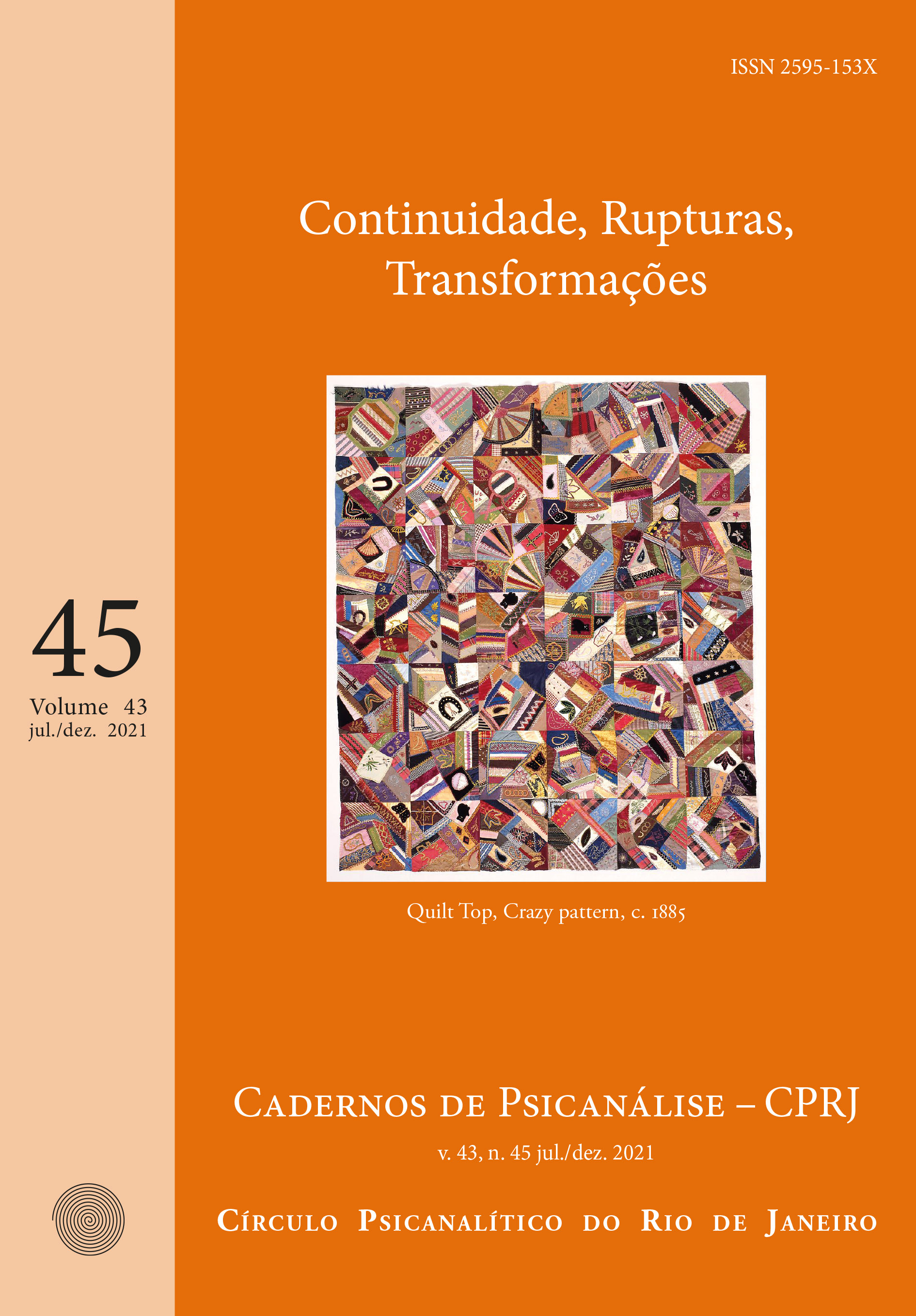Considerações psicanalíticas sobre Os elixires do diabo, de E. T. A. Hoffmann
Resumo
Partimos da constatação de que, apesar de sua importância para o estabelecimento das concepções de infamiliar e duplo, Freud e Rank, por razões diferentes, optam por não se aprofundar nas suas considerações sobre o romance Os elixires do diabo. Situamos então esse livro no contexto da obra de E. T. A. Hoffmann para interrogar a sua relevância para a psicanálise. Destacamos que ele evidencia a dinâmica do Unheimliche e do duplo não apenas como temática do enredo, mas principalmente, como estratégia narrativa. Fazemos referência ao conceito de complexo de Édipo e às categorias lacanianas de Real, Simbólico, Imaginário, estabelecendo daí uma conexão com as sobredeterminações, repetições e ambiguidades que a história retrata.
Referências
ANDRADE, R. S. A face noturna do pensamento freudiano: Freud e o romantismo alemão. Niterói: EDUFF, 2000.
BATALHA, M. C. A importância de E.T.A. Hoffmann na cena romântica francesa. Alea – Estudos Neolatinos, n. 5, v. 2, p. 257-272, 2003. DOI: https://doi.org/10.1590/S1517-106X2003000200008.
BARBOSA, M. A. Introdução - Cavaleiro Gluck: uma lembrança do ano 1809. In: PALMA, A.;
CHIARINI, A. M.; TEIXEIRA, M. J. G. O romantismo europeu: antologia bilíngue. Belo Horizonte: Autêntica, 2013. p. 18-19.
CANTAGREL, L. De lamaledie à l ́ecriture: genèse de lamélancolieromantique. Tübingen: Max Niemeyer, 2004.
CESAROTTO, O. No olho do outro: “O homen de areia” segundo Hoffmann, Freud e Gaiman. São Paulo: Iluminuras, 1996.
FREUD, S. (1914). Zur Einführung des Narzissmus. In: ______. Studienausgabe. v. 3. Frankfurt: Fischer Verlag, 1997. v. 3. p. 37-68.
______. (1919). Das Unheimliche. In: ______. Studienausgabe. Frankfurt: Fischer Verlag, 1997. v. 4. p. 241-274.
______. (1923). Das Ich und das Es. In: ______. Studienausgabe. Frankfurt: Fischer Verlag, 1997. v. 3. p. 241-274.
______. (1926). Hemmung, Symptom und Angst. In: ______. Studienausgabe. Frankfurt: Fischer Verlag, 1997. v. 6, p. 227-308.
______. (1917). Eine Schwierigkeit der Psychoanalyse. In: ______. Gesammelte Werke. Frankfurt: Fischer Verlag, 1999. v. 12. p. 3-12.
______. (1919). E. T. A. Hoffmann sobre a função da consciência. In: ______. O Infamiliar / Das Unheimliche. Belo Horizonte, MG: Autêntica, 2019. p. 127.
HANS, L. A. Dicionário comentado do alemão de Freud. Rio de Janeiro: Imago, 1996.
HAY, G. Nachwort. In: HOFFMANN, E. T. A. Die Elixiere der Teufel. Munique: DTV, 2016. p. 375-383.
HOFFMANN, E.T.A. (1815-16). Die ElixiredesTeufels. Munique: DTV, 2016.
______. (1817). Der Sandmann. In: ______. Das Gesammelte Werke. Colônia: Anaconda, 2015. p. 189-224.
IANNINI, G.; TAVARES, P. H. Freud e o infamiliar. In: FREUD, S. O Infamiliar / Das Unheimliche. Belo Horizonte: Autêntica, 2019. p. 55-22.
JENTSCH, E. Psychologie des Unheimlichen. In: PsychiatrischNeurologischeWochenschrift, n. 22. Halle a. S.: Carl Marhold Verlag, 1906.
LACAN, J. (1949). O estágio do espelho como formador da função do Eu. In: ______. Escritos. Rio de janeiro: Jorge Zahar Editores, 1998. p. 96-103.
______. O seminário, livro 11: os quatro conceitos fundamentais da psicanálise (1964). Rio de Janeiro: Jorge Zahar Ed, 1998.
LACHENMAIER, T. E. T. A. Hoffmanns Figuren: imaginative Spielräume der IchIdentität. Göttingen: Cuvillier, 2007.
LEWIS, M. G. (1796). The Monk. Londres: Penguin Books, 1999.
MASSON, J. M. A correspondência completa de Sigmund Freud para Wilhelm Fliess (1887-1904). Rio de Janeiro: Imago, 1986.
SOUZA JR., P. S. Nota do tradutor. In: FREUD, S. O incômodo: Das Unheimliche (1919). São Paulo: Blucher, 2021.
PETERS, U. H. Morbide Theorienzurseelischen Gesundheit: einigeromantische Wurzeln der gegenwärtigen Psychiatriebei E. T. A. Hoffmann. In: TUNNER, E. (Org.). Romantik – Eine Lebenskraftige Krankheit: Ihre Literarischen Nachwirkungen in Der Moderne. Amasterdã: Ed. Rodopi, 1991. p. 5-37.
POE, E. A. (1839). William Wilson. In: ______. The complete ilustrated Works of Edgard Allan Poe. Londres: Bounty Books, 2006. p. 34-50.
PORTUGAL, A. M. O vidro da palavra: o estranho, a literatura e a psicanálise. Belo Horizonte: Autêntica, 2006.
PRIBERAM. Dicionário da língua portuguesa online, 2020. Disponível em: <http://www.priberam.pt/>. Acesso em: 17 fev. 2020.
RANK, O. Der Doppelgänger. Imago: Zeitschriftfür Anwendung der Psychoanalyseauf die Geisteswissenschaften, v. 3, n. 2, p. 97-164, 1914.
RANK, O. Der Doppelgänger: eine psychoanalytische Studie. Viena: Internatiomaler Psychoanalytischer Verlag, 1925.
ROAS, D. A ameaça do fantástico: aproximações teóricas. São Paulo: UNESP, 2014.
SAFRANSKI, R. E. T. A. Hoffmann: Das Lebenseinesskeptichen Phantasten. Frankfurt: Fischer, 2018.
SILVA, F. V.; COSTA, S. F. A imaginação romântica como neurose? O debate freudiano sobre o animismo e a questão do olhar em E. T. A. Hoffmann.
Pandaemonium Germanicum, v. 22, n. 38, p. 122-141, 2019. DOI: https://dx.doi.org/10.11606/1982-88372238122.
STIEGLER, B. Die Spiegel reflex kamera stamm linde: Bildsysteme. in E.T.A. Hoffmanns Die Elixieredes Teufels. Athenäum, v. 5, n. 1, p. 235–252, 1995. DOI: https://dx.doi.org/10.18452/5642.
SÓFOCLES. A trilogia tebana: Édipo rei, Édipo em Colono e Antígona. Rio de Janeiro: Jorge Zahar Ed., 1998.
TODOROV, T. Introdução à literatura fantástica. São Paulo, SP: Perspectiva, 2012.
TÖLLE, R. Der in die tiefste Tiefeschaute: E.T. A. Hoffmann als Psychopathologe. Würzburg: Königshausen & Neumann, 2012.
WITTKOP-MÉNARDEAU, G. E. T. A. Hoffmanns Lebenund Werk in Datenund Bildern. Frankfurt am Main: Insel Verlag, 1968.
Copyright (c) 2021 Cadernos de Psicanálise | CPRJ

This work is licensed under a Creative Commons Attribution-NonCommercial 4.0 International License.




